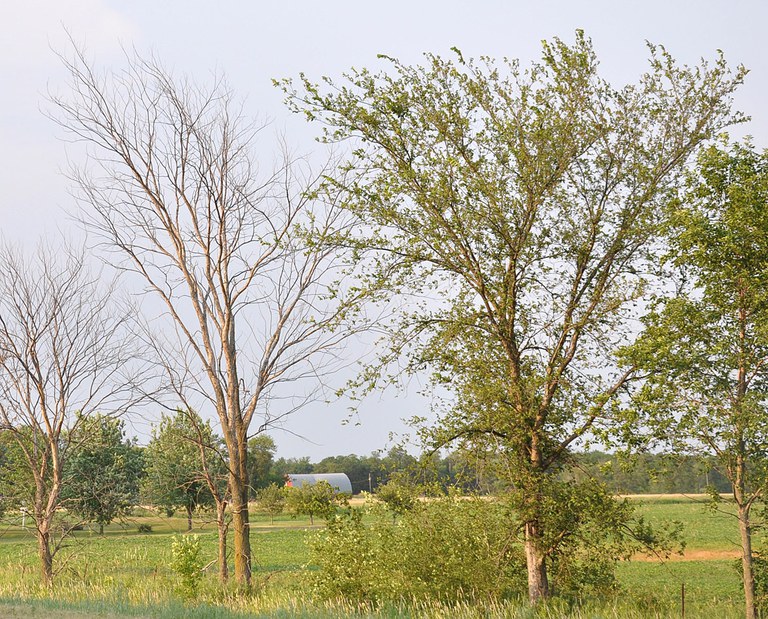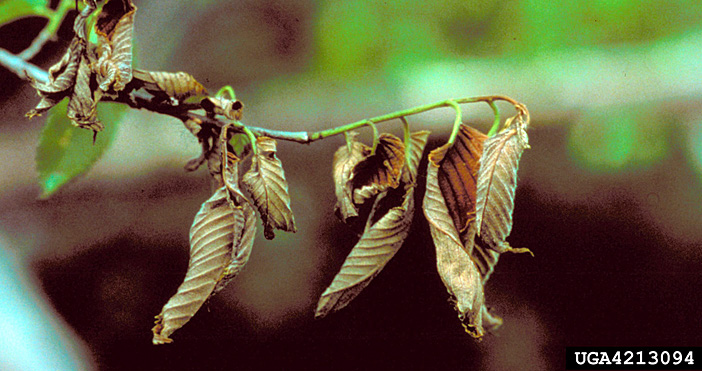Several management tools for DED are available. Using them in the appropriate situations and combinations is the best way to reduce DED and limit its spread.
Sanitation. A year-round communitywide sanitation program is an extremely effective way to slow the spread of DED. Because elm bark beetles breed in dead elm wood with intact bark and in dying elm trees, removing these sources of beetle habitat is essential. This includes removing damaged branches following windstorms, trees weakened by pest attack and fresh elm firewood (all species of elm).
Common ways of disposing of infected elm wood include burning, burying, chipping or debarking cut elm wood. For sanitation to work effectively, identifying newly infected trees continuously throughout the growing season each year and removing them promptly (within 2-3 weeks) is essential. Failure to do so may result in a surge in elm mortality in the following years. A strong municipal ordinance that clears the way for communitywide sanitation on public and private property also is essential to this effort.
Pruning. If infections are identified early enough, they can be removed by pruning. At least 8 to 10 feet of wood that is free of vascular discoloration needs to be removed below the symptomatic branches. Pruning should be conducted October through March. These pruned branches should be destroyed immediately.
Remember to disinfect pruning tools with a 15-20 percent household bleach solution after exposure to DED-infected trees. Due to the uncertainty of pruning out all infected wood, trees pruned in an attempt to remove DED-infected branches should be monitored closely for the development of symptoms below the pruned area.
Severing Root Grafts. To limit the spread of DED through root grafts, the area around infected elm trees can be trenched. If less than 25 percent of a tree crown is damaged by DED, then severing root grafts is a viable management option. These trenches should be 36 to 40 inches deep and completely encircle infected elm trees. The trenches can be refilled with soil immediately, and any infected trees should be removed as part of sanitation efforts.
If more than 25 percent of a tree crown is damaged by DED, the fungus likely has moved into the roots. In that case, root pruning cannot save the adjacent trees.
NOTE: Before trenching, call North Dakota One Call, (800) 795-0555 or 811, to ensure that all underground utility lines are clearly marked.
Fungicides. Fungicide injection may prevent the fungus that causes DED from infecting healthy elms. Two active ingredients, thiabendazole and propiconazole, are registered for controlling the fungus. These chemicals need to be injected directly into the tree root flares by a trained tree care professional.
Fungicide injections are labeled for preventative and therapeutic treatment but are less effective if the tree already is infected.
Fungicides cannot control root graft infections. Fungicide protection against DED may last for three years. Note that while fungicide injection is extremely effective at preventing DED infection, repeated injections can cause irreversible damage to trees and phytotoxicity can occur under certain conditions. Fungicides need to be used in combination with sanitation to be effective in reducing DED.
Resistant Varieties. No species of elm is totally resistant to DED. However, a large amount of variation occurs among species of elm trees. For example, the American elm (Ulmus americana L.) is the most susceptible, and the Siberian elm (Ulmus pumila L.) is the most resistant. Many DED-resistant American elm selections, as well as exotic elm species and hybrids, are available commercially. Contact your local county Extension agent or arborist for a list of the current DED-resistant cultivars.
Insecticide Control. Insecticides are not recommended as a preventative treatment to control adult beetles from transmitting DED spores to uninfested trees, since multiple applications would be needed for the prolonged flight periods and various emergence patterns of different species of elm bark beetles. Other management techniques mentioned above, such as sanitation and fungicide injection, are more efficient and cost effective for the control of DED.






